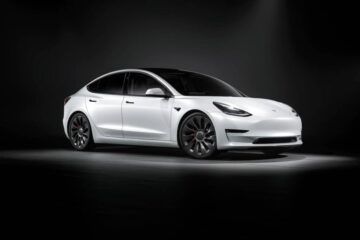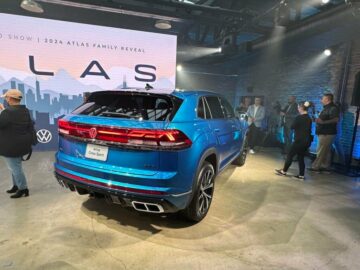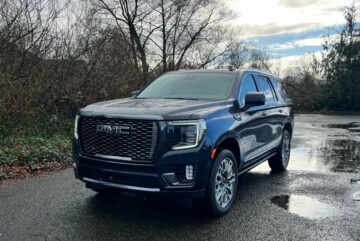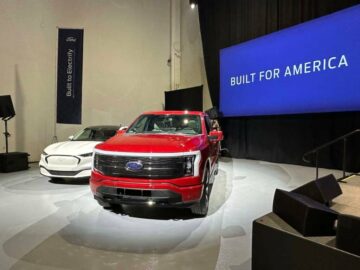The smallest year-over-year price increase in the previous 10 years occurred in July 2023, when Americans paid an average of 0.4% more for a new car than they did a year earlier.

The average transaction price for a new car in July, according to Kelley Blue Book (KBB), was $48,334, down 0.7% from June’s average transaction price of $48,671 and only $199 higher than it was a year earlier.
Transaction prices are down 2.7%, or $1,335, from the beginning of the year, which is the greatest decline from January to July in a decade.
“New-vehicle price inflation has all but disappeared in 2023,” said Rebecca Rydzewski, research manager at Cox Automotive. “New-vehicle prices, primarily driven by cuts in luxury and electric vehicles, are decreasing as inventory is steadily improving. With higher inventories and higher incentives helping to keep downward pressure on prices, there certainly are good reasons for shoppers to be heading back into the market.”
But it’s not merely EV price cuts that are shrinking price increases, as incentives are reappearing as dealers are restocking and inventories rise. The amount spent on incentives by automakers grew in July for the ninth straight month, reaching its highest level since October 2021 with an average of $2,148, or 4.4% of the average transaction price. Spending on incentives was 2.4% of average transaction price a year ago.
The nitty gritty

A new, non-luxury automobile cost $44,700 on average in July, $471 less than in June. Non-luxury pricing only grew by 0.5% on a yearly basis. However, the cost of non-luxury vehicles has been relatively stable since January, varying only by a few hundred dollars, according to KBB.
In July, the average incentive in the non-luxury market increased to 4.3% from 2.5% of average transaction price. Honda, Kia and Toyota, three mainstream brands with relatively low inventories, increased their incentive expenditures in July but lagged below the industry average.
Over the previous year, luxury car prices decreased by roughly 3% in July. In July, the typical luxury consumer spent $63,552, which was $192 less than in June. The cost of luxury goods has decreased by more than 5% since the year began no doubt due to Tesla, the leader in the luxury sector. The automaker has already reduced prices in 2023 by more than 19%. The average price paid for a new Tesla, according to estimates from Kelley Blue Book, was $54,660 in July, down from more than $62,000 in January, and the lowest average transaction price for Tesla since April 2020.
Generally speaking, the luxury market nabbed 19.3% of the market in July, its largest share so far in 2023. Tesla’s reduced prices are probably assisting with sales volume. With 59,813 units sold in July, Tesla sales set a new milestone, according to Kelley Blue Book estimates.
Incentives are rising

In July, incentives reached an annual high of $2,148 and represented 4.4% of the average sale price, up from 4.2% in June. Despite a $112 month-over-month rise in July, incentives are still historically low. In July 2021 and July 2019, respectively, Kelley Blue Book estimated that incentives represented an average of 5.9% and 10.3% of the average sale price.
At 9.6% of the average transaction price, the high-end luxury car class had the largest incentives in July 2023, followed by luxury automobiles at 8.4%, hybrids at 7.7%, entry-level luxury cars at 6.9%, and electric vehicles at 6.7%. The lowest incentives in July were offered on sports cars, high-performance vehicles, and full-size luxury SUVs.
EVs are piling up on dealer lots
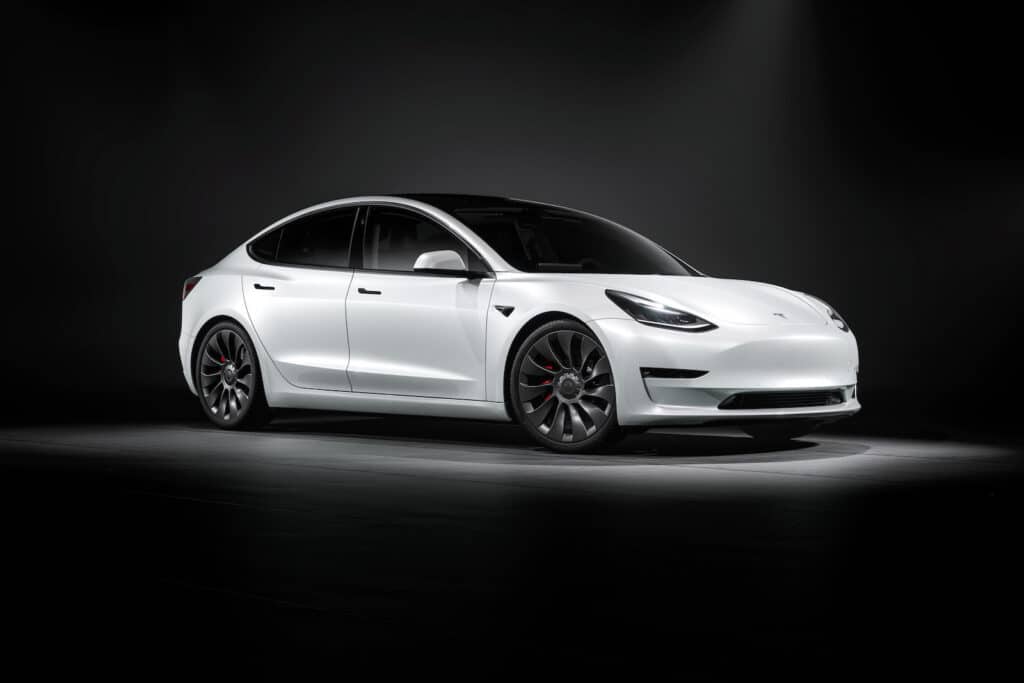
EV prices continue their decline, driven by market leader Tesla. The average EV transaction price dropped to $53,469 in July from $53,682 in June, and more than $61,000 in January. In July, incentives for EVs were equal to $3,755, or 6.7% of the average sale price. To put that in perspective, EV prices peaked at more than $66,000 only a little over a year ago in June 2022. Since then, average EV transaction prices are down more than 19%.
The price decreases in the EV market have coincided with the inventory growth as the days supply of EVs was close to 100 days at the end of July, while the supply of days for the industry stands at a far healthier 54 days.
“The year-over-year decline of EV ATPs has been led by Tesla slashing prices on its popular models,” added Rydzewski. “Tesla prices are down nearly 20% versus a year ago, and other EV models, such as the Ford F-150 Lightning, have been following Tesla’s lead. While automakers report losing money on electric vehicles, they continue to aggressively pursue EV growth strategies.”
Yet prices are still extraordinarily high
But the slowdown in skyrocketing prices shouldn’t suggest that new cars are in any way affordable. According to KBB, only one model traded in July for less than $20,000, the Mitsubishi Mirage at $19,205. Contrast that five years ago in July 2018, when 12 cars had average transaction prices less than with average transaction prices under $20,000. The Hyundai Venue, Kia Rio, Nissan Versa, and Toyota Corolla now fetch far more than $20,000 today. Notably, 32 automobiles in the Kelley Blue Book database, which excludes super exotics from Ferrari, Lamborghini, Rolls-Royce, and the like, averaged more than $100,000 in July, a 167% increase from the 12 vehicles priced at that price level in July 2018.

Financial experts say that buyers shouldn’t spend more than 10% of their gross income on an automobile, but given automakers’ insatiable appetite for unrelenting price increases, that’s becoming difficult.
According to the U.S. Bureau of Labor Statistics, the median U.S. income in the United Stets in the second quarter of 2023, is $1,100 a week, or $57,200 annually. This makes a $48,334 average transaction price a very tough financial pill to swallow, and explains why longer-term auto loans are becoming common.
According to Experian, the average monthly payment for a new vehicle in the first quarter of 2023 increased 10.3% to $725, up from $650 the previous year. Used vehicle monthly payments also rose 2.1% to $516 during the same quarter, up from $505 in the first quarter of 2022.
“We came into this year with affordability at an all-time low due to record prices, interest rates approaching 20-year highs, and tighter credit conditions,” Cox Automotive Chief Economist Jonathan Smoke said. “At mid-year, I believe we can definitively say at least things did not get worse.”
- SEO Powered Content & PR Distribution. Get Amplified Today.
- PlatoData.Network Vertical Generative Ai. Empower Yourself. Access Here.
- PlatoAiStream. Web3 Intelligence. Knowledge Amplified. Access Here.
- PlatoESG. Automotive / EVs, Carbon, CleanTech, Energy, Environment, Solar, Waste Management. Access Here.
- BlockOffsets. Modernizing Environmental Offset Ownership. Access Here.
- Source: https://www.thedetroitbureau.com/2023/08/new-car-price-increases-slowing/
- :has
- :is
- :not
- $3
- $UP
- 000
- 10
- 100
- 12
- 19
- 2%
- 200
- 2018
- 2019
- 2020
- 2021
- 2022
- 2023
- 32
- 7
- 700
- 8
- 9
- a
- According
- added
- affordable
- ago
- All
- all-time low
- already
- also
- Americans
- amount
- an
- and
- annual
- Annually
- any
- appetite
- approaching
- April
- ARE
- AS
- assisting
- At
- auto
- automakers
- automobile
- automobiles
- automotive
- average
- back
- basis
- BE
- becoming
- been
- began
- Beginning
- believe
- below
- Blue
- book
- brands
- Bureau
- bureau of labor statistics
- but
- BUYER..
- buyers
- by
- came
- CAN
- car
- cars
- certainly
- chief
- class
- Close
- coincided
- Common
- conditions
- consumer
- continue
- contrast
- Cost
- Cox
- credit
- cuts
- Database
- Days
- dealer
- decade
- Decline
- decreases
- Despite
- DID
- difficult
- dollars
- doubt
- down
- downward
- driven
- dropped
- due
- during
- Earlier
- Economist
- Electric
- electric vehicles
- end
- entry-level
- equal
- estimated
- estimates
- Ether (ETH)
- EV
- Experian
- experts
- Explains
- extraordinarily
- Falling
- far
- Ferrari
- few
- financial
- First
- five
- followed
- following
- For
- Ford
- from
- get
- given
- good
- goods
- greatest
- gross
- Growth
- had
- Have
- Heading
- healthier
- helping
- High
- High-End
- high-performance
- higher
- highest
- Highs
- historically
- However
- HTTPS
- hundred
- Hyundai
- i
- improving
- in
- Incentive
- Incentives
- Income
- Increase
- increased
- Increases
- industry
- inflation
- interest
- Interest Rates
- into
- inventory
- IT
- ITS
- January
- jonathan
- jpg
- July
- june
- Keep
- Kelley
- Kia
- labor
- Lamborghini
- largest
- lead
- leader
- least
- Led
- less
- Level
- lightning
- like
- little
- Loans
- losing
- Low
- lowest
- Luxury
- Mainstream
- MAKES
- manager
- Market
- Market Leader
- max-width
- merely
- milestone
- Mirage
- model
- models
- money
- Month
- monthly
- more
- nearly
- nearly 20%
- New
- Nissan
- no
- notably
- now
- occurred
- october
- of
- offered
- on
- ONE
- only
- or
- Other
- over
- Pace
- paid
- payment
- payments
- peaked
- perspective
- plato
- Plato Data Intelligence
- PlatoData
- Popular
- pressure
- previous
- price
- Price Increase
- Prices
- pricing
- primarily
- probably
- put
- Quarter
- Rates
- reached
- reaching
- reasons
- record
- Reduced
- relatively
- report
- represented
- research
- Rise
- rising
- Rolls-Royce
- ROSE
- roughly
- s
- Said
- sale
- sales
- Sales Volume
- same
- say
- Second
- second quarter
- sector
- set
- Share
- Shoppers
- since
- slashing
- Slowdown
- Slowing
- smallest
- Smoke
- So
- so Far
- sold
- speaking
- spend
- Spending
- spent
- Sports
- stable
- stands
- statistics
- Still
- straight
- strategies
- such
- suggest
- Super
- supply
- SUVs
- talking
- Tesla
- than
- that
- The
- their
- then
- There.
- they
- things
- this
- this year
- three
- tighter
- to
- today
- tough
- toyota
- traded
- transaction
- typical
- u.s.
- under
- United
- units
- used
- vehicle
- Vehicles
- Venue
- Versus
- very
- volume
- was
- Way..
- we
- week
- were
- when
- which
- while
- why
- with
- worse
- year
- yearly
- years
- zephyrnet

